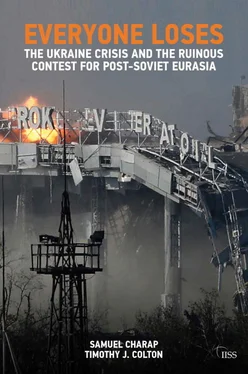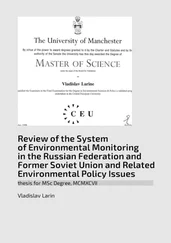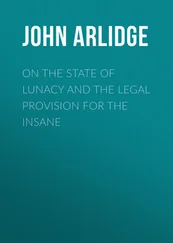The Kremlin has used the charged political environment to enact legislation that curbs free expression and strictly limits non-governmental links to the West. Examples include stiffer fines for support of separatism and for participating in unauthorised protests; a law requiring any blog with more than 3,000 daily readers to register and be regulated as a media outlet; and a provision allowing the prosecutor’s office to brand as ‘undesirable’ foreign non-governmental organisations that ‘threaten constitutional order, defence capabilities or national security’. Once so designated, an organisation is forbidden from maintaining an office in Russia and disseminating its work in the country. By autumn 2016, the US National Endowment for Democracy, the National Democratic Institute, the International Republican Institute and the Open Society Foundation, among others, had been designated undesirable.
As in Ukraine, the conflict also radicalised Russian political discourse. In the months following the seizure of Crimea, TV news anchors, talk-show hosts and pro-government politicians slandered the Kremlin’s opponents with the terms ‘fifth column’ and ‘national traitors’, terminology that Putin had endorsed in his 18 March 2014 speech announcing the annexation. Politicians and journalists who spoke out online against government policies were hounded by a paid army of pro-government internet trolls. [31] See, for example, Adrian Chen, ‘The Agency’, New York Times Magazine , 2 June 2015, http://www.nytimes.com/2015/06/07/magazine/the-agency.html .
Many other online attacks – including some that contained threats of violence – came from Russian nationalists who were not on the Kremlin payroll. Nationalist – or more accurately, pan-Slavic neo-imperialist – groups, long frozen out by the authorities, felt newly empowered by the annexation of Crimea and the war in Donbas, in which their members played a role as volunteer fighters. [32] Once the Russian military became more directly involved in the fighting in the Donbas, these nationalist volunteers were pushed out of the limelight. Those who resisted Moscow’s effort to impose control ended up in a basement prison or, in some cases, dead; most returned to Russia. Some became outspoken critics of what they saw as feckless government policy.
Russia’s position in international politics has also worsened in certain ways since 2014. Its allies in the neighbourhood, while outwardly compliant, worry that one of them might be the next target and hedge against Moscow as much as their circumstances allow. Further west, countries that had previously been on the dovish end of the debate over policy toward Russia within NATO and the EU now see it very differently. In 2013, it would have been inconceivable for the German government to label Russia ‘a challenge to the security of our continent’, as its 2016 defence white paper did. [33] Federal Ministry of Defence, ‘White Paper on German Security Policy and the Future of the Bundeswehr’, 13 July 2016, p. 32, link .
Berlin has led the effort to maintain unity within the EU on Russia sanctions. Moscow is at serious risk of permanently alienating the entire EU, which as a bloc has long been Russia’s largest trading partner and direct investor. With its Western partnerships blighted, Russia is becoming more dependent on China both economically and geopolitically, and over time that may limit its freedom of manoeuvre.
Both Russia and the West have been left worse off by the period of confrontational relations that began in 2014. This Cold War-like climate has impeded cooperation on shared challenges, raised risks of a military clash, and transformed civil conflict into proxy hot wars in Ukraine and Syria. In Europe, new tensions between Russia and NATO have led to a significant deterioration in the security environment. The US withdrew its last battle tank stationed in Europe in 2013; 6,000 had been deployed in Germany at the height of the Cold War. That trend, which facilitated a gigantic peace dividend for the US and the EU, is now being reversed. [34] See Samuel Charap and Jeremy Shapiro, ‘Consequences of a New Cold War’, Survival: Global Politics and Strategy , vol. 57, no. 2, April–May 2015, pp. 37–46.
The frontier between Russia and the alliance is the locus of a new build-up. The US earmarked US$789m in the fiscal year 2016 and US$3.4bn in 2017 to expand its military presence in East Central Europe, including periodic rotations of armoured and airborne brigades to Poland and the Baltic states. Following consultations at a NATO summit in Warsaw in July 2016, Canada, Germany and the UK now have troops on persistent rotation in the Baltic states. The alliance has also stepped up military rehearsals and manoeuvres, conducting the largest exercise since the end of the Cold War in June 2016.
The NATO moves are a response to genuine threat perceptions of East Central European allies over Russia’s behaviour since 2014. Regardless, Moscow sees in them nothing more than a continuation of the long-running process of NATO moving its military infrastructure closer to Russia’s borders. In response, Russia has announced a build-up in its Western Military District. In May 2016, Russian Minister of Defence Sergei Shoigu said that the army would form two new infantry divisions in the district by the end of 2016. [35] It would take some time to compensate for the post-1991 drawdown of Russian forces in its western quadrant. Compared with Russia’s other frontiers, the western remains less heavily guarded.
The Kremlin has also responded asymmetrically. Since 2014, Russia has abducted an Estonian intelligence officer; intensified submarine patrols in the North Atlantic; provided moral and, it has been reported, financial support to eurosceptical and anti-EU parties; and engaged in dangerous brinksmanship in the skies and on the seas, with repeated near misses between Russian air patrols and Western jets (civilian and military) and warships. [36] On support for eurosceptical parties, see Suzanne Daley and Maïa de la Baume, ‘French Far Right Gets Helping Hand With Russian Loan’, New York Times , 1 December 2014, http://www.nytimes.com/2014/12/02/world/europe/french-far-right-gets-helping-hand-with-russian-loan-.html .
NATO and Russia have come closest to a direct military clash in Syria. In September 2015, two days after a meeting between Putin and Obama failed to produce agreement, Moscow began bombing opponents of the Syrian regime – its first military intervention beyond the former Soviet region since the USSR invaded Afghanistan. Russian and NATO warplanes were operating in the same theatre but pursuing competing if not conflicting objectives. Less than three months later, a Turkish pilot downed a Russian military jet near the Syria–Turkey border, the first head-to-head clash between Moscow and a NATO country since the Korean War. Several close calls have occurred in Syria since then, including a near miss between US and Russian warplanes in June 2016.
It bears noting that the shattering of US–Russia ties as a result of the Ukraine crisis helped pave the way for Russia’s intervention in Syria. While the facts in and around that war-torn country were the primary motive for the move, it was the breakdown in relations that led Russian decision-makers to believe that only military force could compel Washington to take into account its interests in Syria. And the Ukraine crisis further incentivised Moscow to act in order to break out of the diplomatic isolation that the West had attempted to impose after Crimea and demonstrate that Russia could not be denied its rightful place at the high table of international politics.
The nuclear sabre-rattling associated with the Cold War has returned, although in different forms. In an interview in March 2015, Putin said that he considered putting Russia’s nuclear forces on alert during the Crimea operation. In November 2015, Russia’s state-owned Channel One displayed images of a general studying plans for a nuclear-armed torpedo, ‘Status-6’, a doomsday retaliation weapon that could irradiate the entire US east coast. US Secretary of Defense Ashton Carter has named Russia as a top threat to the US and spared the nuclear-weapons budget from any cuts, despite strict budgetary sequestration imposed by Congress. [37] ‘Remarks Previewing the FY 2017 Defense Budget’, 2 February 2016, http://www.defense.gov/News/Speeches/Speech-View/Article/648466/remarks-previewing-the-fy-2017-defense-budget .
Furthermore, several arms-control and confidence-building regimes that helped end the Cold War peacefully seem near collapse. This is particularly true of the 1987 Intermediate-Range Nuclear Forces Treaty. Russia and the US have accused each other of violating it, and the current atmosphere in the relationship makes a diplomatic resolution almost unthinkable. In short, there is a very real risk of returning to a time when miscalculations in Moscow or Washington can at any moment lead to the destruction of life on earth.
Читать дальше











